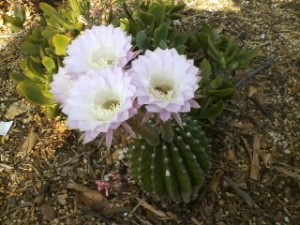CSUN-al Gardening Gets Hands On with Succulents

Echinopsis flowers
Succulent plants have thickened parts that store water and energy for use during dry seasons. Occurring in many diverse plant groups such as agaves, cacti, sedums, echeverias and tradescantias, this survival technique also makes succulents highly suitable for people who forget to water their plants.
From 9 to 11 a.m. on Saturday, Sept. 24, succulent enthusiast Sandy Masuo will take attendees of the first CSUN-al Gardening class of California State University, Northridge’s 2016 fall semester on a visual tour of her favorite succulents and share her approach to growing the most popular varieties.
“Succulent plants are adapted to survive extended periods without water,” said Brenda Kanno, manager of CSUN’s Botanic Garden. “As a result, they have developed notable features such as spines, thick leaves or fat trunks. Mature, well-grown specimens are highly coveted by plant collectors.”
Masuo is a self-described “plant nerd” whose passion for gardening has led her to the Theodore Payne Foundation for Wild Flowers and Native Plants, where she is a docent; the Southern California Horticultural Society, where she has served on the board of directors; and Glendale Community College, where she teaches a popular succulent centerpiece class. She is an associate editor in the Los Angeles Zoo Publications Division and edits the Association of Zoological Horticulture’s newsletter. Her professional writings have appeared in the Los Angeles Times, the San Francisco Bay Guardian and Rolling Stone magazine. She also penned the foreword to the newly published novel, “Unnatural Selection: Lessons of Life and Death on the Paper Trail,” by Rosana DuMas (her alter ego).
As a bonus, following the lecture, Masuo will demonstrate how to design and assemble an eye-catching succulent container. Attendees are welcome to bring a small (8 inches or less in diameter) container to class, ready to be filled with potting medium and succulent cuttings. This part of the class will take place outdoors in CSUN’s Botanic Garden, so attendees should be prepared for hands-on activities in sunny, hot weather — gloves and a brimmed hat are recommended.
Those interested in taking part in the hands-on portion of the class should indicate their interest when they register, so organizers can provide enough soil and cuttings. Registration for the free class is required to attend the lecture and the hands-on portion of the class. Please email botanicgarden@csun.edu to request a space in the class or for more information. Directions and parking instructions, as well as the class meeting location, will be sent upon registration.
CSUN’s Botanic Garden is operated by the university’s Department of Biology and serves as a field site for botany, entomology, photography, painting and other classes. In addition to geographically themed plantings and a butterfly garden, the garden features greenhouses where noteworthy botanical specimens are grown. The garden is open to the community. Visit the Botanic Garden’s website, www.csun.edu/botanicgarden, for more information.

 experience
experience